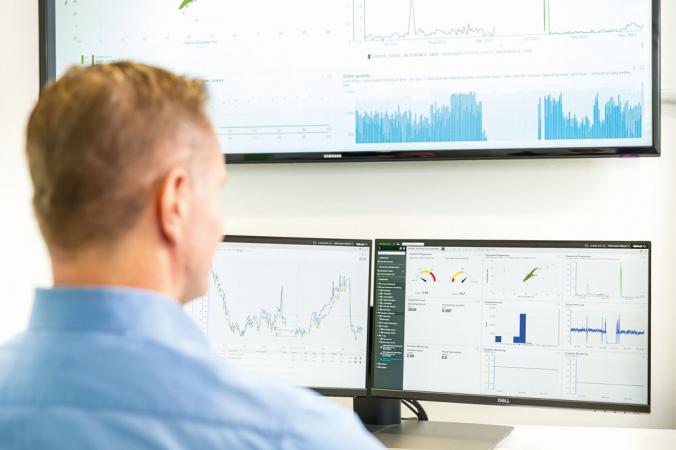Thermal Imaging Ensures Continuous Steel Production
Production plants have to keep running all the time. No breakdown, no downtime. To ensure proper operation of its production plants in Vanderbijlpark, ArcelorMittal South Africa uses thermal imaging cameras. This improves efficiency, safety, helps avoid breakdowns and to minimize downtime.
The ArcelorMittal plant at Vanderbijlpark has the capacity to produce 4.4 million tonnes of liquid steel per year, which constitutes some 78 percent of South Africa’s flat steel requirements. It is one of the world’s largest inland steel mills and the biggest supplier of flat steel products in sub-Saharan Africa.
To keep all of the plant’s equipment up and running is the task of the Condition-Monitoring Team at the Reliability Engineering Department of ArcelorMittal South Africa. The team uses many condition monitoring tools, thermal imaging is one of them.
– The advantage of using thermal imaging cameras is that you can see a problem developing long before it becomes visible to the naked eye, enabling you to make informed decisions regarding a suitable course of action. This leads to increased production, improved safety and increased equipment lifespan, explains Douglas Glen, Senior Thermographer at the Condition-Monitoring Team.
The Advantage of Thermal Imaging
Thermal imaging technology is a perfect solution, according to Glen.
– You can perform thermal imaging inspections during operation and while electrical systems are under load. No downtime is required.
Of course thermal imaging is not the only condition-monitoring tool used at the plants of ArcelorMittal South Africa.
– We combine several technologies such as vibration analysis, oil analysis and inspections using thermal imaging cameras. The main advantage of thermal imaging is that you can locate mechanical and electrical problems very quickly and accurately. With thermal imaging you can immediately see which component is causing the problem.
Thermal imaging cameras also help speed up the inspections.
– Often there are simply too many pieces of equipment for vibration analysis or other methods. We monitor 13,168 electrical panels, 6 rotating kiln furnaces, two blast furnaces, one Basic Oxygen Furnace (BOF), three large arc furnaces and several furnaces of other types. That’s a lot of equipment. With our thermal imaging cameras we ensure that no fault is overlooked, while saving a lot of time, says Glen.
According to Glen some types of equipment can only be inspected using thermal imaging cameras.
– With refractory linings, for instance, thermal imaging cameras are the only practical condition-monitoring tool available. With a thermal imaging camera you can scan large areas of refractory material and immediately see where the refractory insulation is failing.
– Before we started using Flir thermal imaging cameras we already used cameras from other manufacturers, Glen explains.
– Over a decade ago we bought our first Flir thermal imaging camera, and it was immediately clear to us that Flir was the leader in the field. Since then we have bought several new thermal imaging cameras. All of these thermal imaging cameras see daily use and have proved to be extremely reliable.
ArcelorMittal South Africa acquired their thermal imaging camera from the Johannesburg, South Africa, based Flir products distributor Yellotec. As a solution-oriented company Yellotec specializes in industrial technologies. It has a long-standing history with Flir products going back almost 20 years. Yellotec can be considered to be the most experienced thermography related company in the country, because it employs the most experienced and knowledgeable personnel active in the South African Thermography market and its sales people are at least qualified to a minimum of Thermography Level 2.
Details of the Camera
The Flir P640 thermal imaging camera contains an uncooled microbolometer detector that produces excellent quality thermal images of 640 x 480 pixels at a thermal sensitivity of 30 mK (0.03 °C).
– One of the reasons why we chose this camera – apart from the excellent image quality and accuracy – is its ergonomic design, explains Glen.
– If you use a piece of equipment as often as we use the thermal imaging cameras, ergonomics and ease of use are crucial. This camera model delivers just that. Especially the tiltable viewfinder comes in handy, as it allows us to look at equipment from all possible angles.
Another reason for their choice in thermal imaging camera model was the fact that it has interchangeable optics.
– This is very important for us because we also perform high voltage inspections of overhead power lines, both for our own premises and for the local municipality. For those long distance inspections a 7° angle telephoto lens is indispensible. In other situations the standard 24° lens is needed, for the telephoto lens simply has a too narrow field of view. The ability to change the lens gives the operator much more flexibility.
To facilitate comparison between new recordings and previous reports the condition monitoring personnel also has an iPod Touch attached to the left arm.
– This allows us to look up previous reports so we can immediately see if anything has changed. This helps us to quickly and accurately spot defects. The added benefit of the Flir Viewer Mobile App that we downloaded from the Apple Store is proving to be invaluable. Using the iPod Touch together with our thermal imaging cameras has enabled us to increase our efficiency by about 30 percent.
Training Is Important
The ergonomic design and ease of use of thermal imaging cameras can also be slightly deceptive, however, according to Glen.
– The thermal imaging cameras are so easy to use that you might think it’s just a matter of point and click, but it is essential that you know what you are doing. You need extensive knowledge of thermal physics and thermal imaging technology to accurately analyse thermal images. Otherwise you will likely draw false conclusions.
That is why Glen and his colleagues opted for training at the Infrared Training Center (ITC).
– All of our operators are ITC trained. I have a level 3 certificate, which is currently the highest level, and my colleague Nico Pieterse has the level 2 certificate.
With their thermal imaging cameras Glen and his team have helped ensure the continuity of production at the plants of ArcelorMittal South Africa, saving their company a lot of money in the process.















